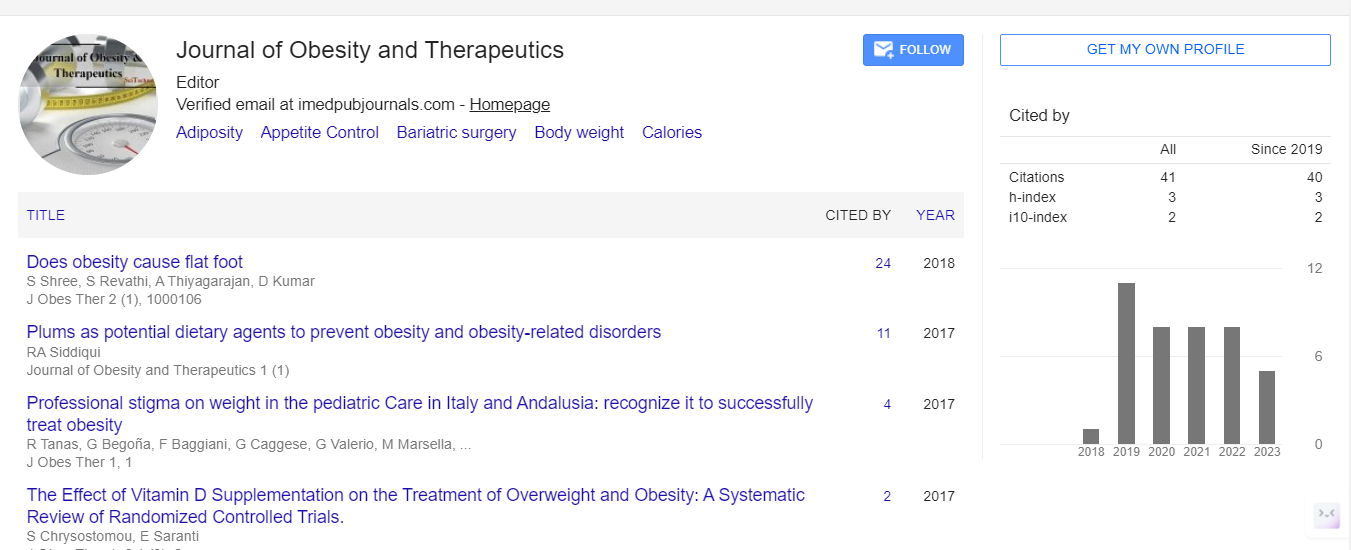Commentary, J Obes Ther Vol: 6 Issue: 3
The Importance of Gastric Pouch Reduction
Prem kumar*
Department of Community Medicine, Yenepoya Medical College, Mangalore, Karnataka, India
*Corresponding Author:Prem kumar
Department of Community Medicine, Yenepoya Medical College, Mangalore, Karnataka, India
Email: Premkum9@gmail.com
Received date: 02 May, 2022; Manuscript No. JOT-22-59965;
Editor assigned date: 04 May, 2022; Pre QC No. JOT-22-59965 (PQ);
Reviewed date: 13 May, 2022, QC No. JOT-22-59965;
Revised date: 23 May, 2022, Manuscript No: JOT-22-59965 (R);
Published date: 02 June, 2022, DOI:10.4172/jot.1000122.
Citation: kumar P (2022) The Importance of Gastric Pouch Reduction. J Obes Ther 6:3.
Keywords: Gastic
Introduction
Laparoscopic Sleeve Gastrectomy (LSG) is well normal as a stand-by myself bariatric procedure and currently, after Laparoscopic Roux-en-Y Gastric pass (LRYGB), the second-most accomplished bariatric manner global displaying a rise in prevalence from 0% in 2003 to 37% of the world general (n=468.609) in 2013 . A downside of this system is that in approximately 15% of patients inadequate weight reduction, full-size weight regains or gastroesophageal reflux following the number one system is discovered necessitating revisional surgery. Several revisional processes consisting of resizing the sleeve, banding of the sleeve, conversion of the sleeve right into a gastric pass a mini gastric pass, duodenal switch or unmarried anastomosis duodeno-ileal pass with sleeve gastrectomy (SADI-S) were proposed to acquire in addition weight loss.
A complete of 1343 primary LSGs have been executed among September 2006 and August 2014. Our cohort (n=42, 3.1% of the full, represents a huge a part of our acknowledged institution of patients transformed into LRYGB after LSG (n=84, 50%). Actively contacting our sufferers to boom observe-up quotes ended in observe-up chances of 100%, seventy 3.8% and 50% for follow-up terms of respectively 1, 2 and 3 years; these charges were similarly allotted over each organizations. With increasing numbers of bariatric processes being done globally, the quantity of patients who do now not acquire the favored weight reduction also rises, no matter the implemented manner. Consequently, a vital element of bariatric surgical procedure is revisional surgical procedure. As LSG is currently the most common finished method global, the question arises which secondary procedure might be most effective in attaining additional weight loss in case of insufficient weight loss or widespread weight regain. Consensus regarding this count number has now not yet been mounted and inadequate weight reduction and weight regain stay a difficulty for each the patient and the bariatric general practitioner. Reviews on conversion of LSG to LRYGB are restricted, talk small numbers of converted sufferers and additionally include revisions of gastroesophageal reflux after LSG. Gautier et al. Mentioned on 18 conversions of which nine 9 were due to insufficient weight loss; an additional BMI lower from 40.9 kg/m2 before revision to 35.8 kg/m2 were found within FU 3.6-31.1 months. Langer et al. Mentioned on 8 revisions of LSG into LRYGB of which 5 for weight regain. After conversion, a median weight reduction of 15.2±8 kg became done within FU 1-fifty two months. due to the fact that then, numerous different reports on revisional surgery after primary LSG had been posted aiming to growth perception into which revisional method yields the excellent consequences in terms of additional weight loss.
Factors Causing Obesity
Our potential database of bariatric procedures contained patient records approximately the primary procedure. Records approximately the revisional technique was retrospectively retrieved from the written and electronic patient statistics. Outpatient and clinical records at the number one and the revisional technique had been received beginning from the preoperative primary LSG visit up to 3 years after the revisional LRYGB manner. The number one outcome parameters have been body weight (kg), body-mass index (BMI), percent extra BMI loss (%EBMIL) and percentage overall weight reduction (%TWL).
 Spanish
Spanish  Chinese
Chinese  Russian
Russian  German
German  French
French  Japanese
Japanese  Portuguese
Portuguese  Hindi
Hindi 